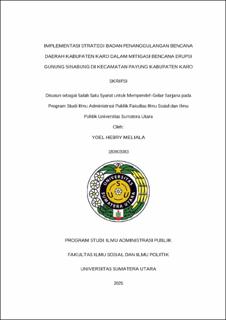| dc.description.abstract | The eruption of Mount Sinabung caused physical damage and socio-economic conditions of residents living and working around Mount Sinabung. A series of earthquakes, eruptions, and hot cloud avalanches continued to haunt and forced tens of thousands of people to take refuge in evacuation posts, especially in Payung District which is at the highest level of threat of Mount Sinabung eruption. Therefore, preparedness in facing disasters needs to be focused.
This study aims to describe and analyze how the Implementation of the Karo Regency Regional Disaster Management Agency Strategy in Mitigating the Mount Sinabung Eruption Disaster in Payung District, Karo Regency. The method used in this study is a descriptive method with a qualitative approach. Data collection techniques used are interviews, observations, documentation, literature studies, and data from the web. This study uses the strategy implementation theory from Hunger & Wheelen, with three main indicators, namely program creation, budget allocation, and determination of procedures (SOP).
The results of the study show that (a) in program creation, the Karo Regency BPBD has implemented various mitigation activities, such as the formation of Disaster Resilient Villages, disaster response family training, and disaster socialization and education. To date, 14 Disaster Resilient Villages have been formed in areas affected by the eruption. However, the scope of the program still needs to be expanded to be more evenly distributed across all areas at risk. (b) In budget allocation, it was found that the BPBD still uses a general budget for various types of disasters, so it has not been specifically allocated for mitigating the eruption of Mount Sinabung. Although the budget for disaster prevention and preparedness reaches IDR 1.5 billion, the budget for post-disaster recovery is still limited, resulting in a lack of support for affected communities. (c) in determining procedures, the BPBD has standard procedures in disaster mitigation, including evacuation, provision of logistics, and coordination between agencies. However, its implementation still experiences obstacles, especially in the socialization of SOPs to the community and the lack of cross-sector coordination. | en_US |


